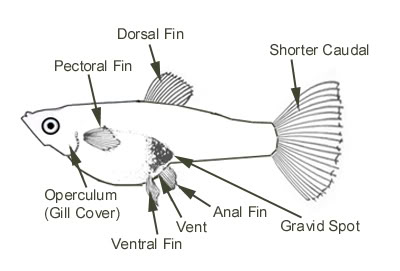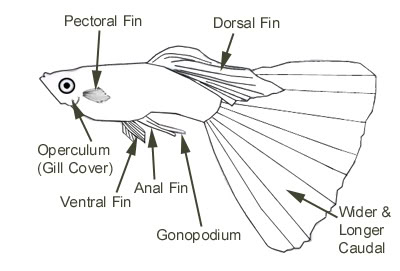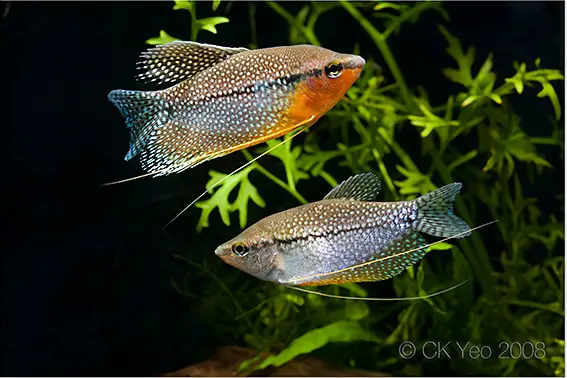I see a lot of people ask “what fish should I start
with?” I also see a lot of people starting with fish that they were lead to
thinking were easy. Most people want a
tank full of beautifully colored fish. I understand this, but often the most
beautiful fish are also much more delicate. However, there are some very pretty
and hardy fish with which you can start your hobby. They may not look like much
in the store tanks, but once you get them home and into a good setup, they will
show their true colors for you.
Through personal experience and discussion with other
aquarists, I have gathered a list of fish that are good for the budding
fishkeeper. These fish were chosen for their hardiness (ability to survive a
cycle and live in less than ideal conditions), adaptability (can live in a wide
range of parameters), small size (ideal for the first aquarium), and
peacefulness. I have also compiled a list of fish that beginners should avoid for
various reasons such as size, aggressiveness, and sensitivity.
Before I go into the fish, let me take a minute to
explain what a good first aquarium size is. While bigger is always better, the
beginner might not want to start with a massive tank of 55 gallons (209 L) or larger.
This is a big tank (and a big expense), and big tanks mean big water changes
which a new aquarist might not want. Conversely a 10 gallon (40 L) isn’t a great
beginner tank because it is so small, and small tanks can have fast and dangerous
water parameter swings. Also you can only fit one or two species of fish in a
tank of that size. I’ve come to believe that tanks from between 20 gallons (75 L) and
40 gallons (151 L) make great beginner tanks because they are large enough to be mostly
stable but not too large as to be a pain to perform water changes and they
enable the first time fishkeeper to keep more than two species.
The Bad Choices
Many fish that the pet stores tout as easy and great for
beginners are far from that for many reasons. Some grow too large, some are hard
to keep alive, and some are aggressive. Since there is a multitude of fish that
would make poor first choices, I’m going to group them into categories and give
you examples of fish that fall into these categories.
The first category of poor beginner fish are chosen
because they get so large. They are sold as cute, inch-long babies, but they
will soon be busting the walls of a normal beginner aquarium. These fish
include goldfish (Carassius auratus
auratus), common pleco (Hypostomus
plecostomus), oscar (Astronotus
ocellatus), and kissing gourami (Helostoma
temminkii). Many people are surprised to see goldfish on this list because
all you see in the stores are cute little goldfish. Trust me: these little
golden wonders will soon be around a foot long and all the while they grow,
pooping like a fiend. They are a hardy fish, but they just get too large for
most beginners to handle.
You also don’t want to start off with a fish that is too
sensitive. Oto catfish (Otocinclus
macrospilus), angel fish (Pterophyllum
spp), cardinal tetra (Paracheirodon
axelrodi), and many more fall into this category. They should never be
introduced to a cycling tank (tank where colonies of beneficial bacteria are
not established and harmful levels of ammonia and nitrite are present) because
they can’t handle the stress of a cycle. Oto catfish specifically need a setup
that has had time to grow algae because they primarily eat algae. They come to
stores starving because they are captured from the wild where they only eat
algae. By the time they get to the store they haven’t seen any in weeks; they
will starve to death in a brand new setup because it lacks algae.
Another mistake that beginners often make is buying fish
that are too aggressive to keep with much else; they end up with a moderately
large tank and nothing in it but a single school of fish. Or they buy a
“freshwater shark” because the name sounds cool, and then end up with a tank
full of fish cowering in the corner trying to stay away from the shark’s
bullying nature. If you just want to keep a school of these fish or a freshwater
shark, then go right ahead, but you won’t be able to add anything else to the
tank. Fish that fall into this category are tiger barbs (Puntius anchisporus), black skirt tetra/black widow tetra (Gymnocorymbus ternetzi), and the
freshwater sharks like rainbow shark (Epalzeorhynchos
frenatus), bala shark (Balantiocheilos
melanopterus), and red-tailed shark (Epalzeorhynchos
bicolor).
Guppies (Poecilia
reticulata) are a great beginner fish, right? You’d be surprised to learn
that they are not. They were many years ago, but commercial scale breeding and
continuous inbreeding has made what was once an extremely hardy fish into a
weak, disease-ridden fish terrible for beginners. If you can find guppies from
a hobby breeder, then you have the chance to get some good fish, but pet store
guppies are so weak, they can hardly be considered a good fish anymore. Sadly,
neon tetra (Paracheirodon innesi) and
dwarf gourami (Trichogaster lalius)
have also gone down this same route. Commercial-scale breeding programs are now
producing weak, inbreed, and disease ridden fish. In fact, both fish now have a
disease named after them because these fish so commonly carry them: dwarf
gourami iridovirus and neon tetra disease. These diseases have no cure and can
spread to other species.
I know you want to start off with strange and unusual
fish to wow your friends, but these fish are usually delicate, difficult to
keep alive, and have specific needs. This brings me to my final category of
fish that are bad for beginners: the oddballs. These are fish like the black
ghost knifefish (Apteronotus albifrons),
German blue ram (Mikrogeophagus ramirezi),
and African butterfly fish (Pantodon
buchholzi). A good rule of thumb is if it looks strange, it’s going to be
hard to keep alive.
The Good Choices
Don’t despair. While those are fish you shouldn’t start
with, you have plenty of attractive and interesting options that can be your
first fish. Instead of grouping them like the bad beginner fish, I have listed them
out with pictures and general care information. All of these fish are not picky
eaters and will readily accept any flake or pellet food.
 |
| Blue Tetra (Catxx @ the Aquarium Wiki) |
Blue Tetra, Cochu (
Boehlkea
fredcochui)
Tank size: 20 gallons, 24 inches long (75 L, 61 cm)
Temp: 72 - 79F (22 - 26C)
pH: 6.0 - 8.0
Water hardness: up to 15 dGH
Notes: Like most tetra species this is a schooling
species and needs to be maintained in groups of 6 or more. When buying
schooling fish like this it is best to buy about 9 so in case you have a death,
these fish won’t start bullying other fish. Don’t keep them with fish with long
fins like betta fish. This fish will be most colorful in an aquarium with lots
of cover such as decorations and plants (live or fake).
 |
| Group of Flame Tetra (Catxx @ the Aquarium wiki) |
Flame tetra, Fire tetra, Von Rio tetra (
Hyphessobrycon flammeus)
Tank size: 20 gallons, 24 inches long (75 L, 61 cm)
Temp: 72 - 82F (22 - 28C)
pH: up to 7.8
Hardness: up to 25 dGH
Notes: This is another gorgeous and hardy tetra species.
They should be kept in a minimum of 6, but keeping them in larger numbers will
make them more attractive and reduce the nipping tendencies common with tetra.
Don’t keep them with slow-moving fish. It will show its best colors in an
aquarium with lots of decorations such as fake or live plants.
 |
| X-ray tetra (Debivort @ Wikipedia) |
Pristella tetra, X-ray tetra, X-ray fish, Goldfinch tetra
(Pristella maxillaris)
Tank size: 10 gal, 20 inches long (40 L, 50 cm)
Temp: 74 - 82F (24 - 28C)
pH: up to 8.0
Hardness: up to 30 dGH
Notes: In my opinion, this is one of the best beginner
fish because it is so easy to keep. It will survive in all but the most hard of
municipal water supplies. Like all tetra, it should be kept in groups of 6 or
more at a minimum.
 |
| Bronze cory cats (public domain) |
Bronze Cory Cat, Albino cory (Corydoras aeneus)
Tank size: 20 gal, 24 inches long (75 L, 61 cm)
Temp: 70 - 80F (21 - 27C)
pH: 6.0 - 8.0
Hardness: up to 20 dGH
Notes: Also found in an albino form, the bottom-swimming
bronze cory is a great addition to a new fishkeeper’s aquarium. They will do
best with a sand bottom but can manage with smooth gravel. It will be most
active when kept in groups larger than 5. Three is the minimum that should be
kept together as these fish are very social.
 |
| Two harlequin rasbora (Stee @ flickr) |
Harlequin Rasbora, Red rasbora (Trigonostigma heteromorpha)
Tank size: 20 gal, 24 inches long (75 L, 61 cm)
Temp: 70 - 82F (21 - 28C)
pH: below 7.5
Hardness: up to 15 dGH
Notes: A common fish in pet stores, it is a great choice
for a beginner. This is another social fish that needs to be maintained in
groups of 6 or more, but it will fare best with groups of 10 or more.
 |
| Two Bandit cories (Stuart Halliday) |
Bandit cory, Masked cory (Corydoras metae)
Tank size: 10 gallons, 20 inches long (40 L, 50 cm)
Temp: 70 - 77F (22 - 25C)
pH: up to 7.5
Hardness: up to 15 dGH
Notes: As they are more shy than bronze cories, they
should be kept in groups of 6 or more. They will be much more active in larger
groups. When kept singly or with 1 or 2 other bandit cories, they will not be
seen much and may be too shy to feed. They like a sand bottom best as they
enjoy rooting around in the sand for morsels of food.
 |
| Regular zebra fish (public domain) |
 |
| Glofish, genetically modified zebra danio (www.glofish.com) |
Zebra danio/glofish (Danio
rerio)
Tank size: 20 gallons, 24 inches long (75 L, 61 cm)
Temp: 65 - 77F (18 - 25C)
pH: 6.0 - 8.0
Hardness: up to 20 dGH
Notes: Also sold as the brilliantly colored glofish,
these peaceful little schoolers make a much better candidate for a smaller
unheated aquarium than goldfish do. The zebra danio that are sold as glofish aren’t
dyed. They are actually genetically engineered to be that way by having
jellyfish and coral genes implanted in their own. They will pass this down to
their children, too. Like all schooling fish, these active little swimmers need
at least 6 of their own kind to feel safe (you can mix glofish and the regular
zebra danio). As a precautionary, I feel like I need to mention that due to
massive inbreeding, this fish are becoming less and less hardy; one day they
might not be good beginner fish.
 |
| Glowlight tetra (gonzalovalenzuela @ flickr) |
Glowlight tetra (Hemigrammus
erythrozonus)
Tank size: 20 gal, 24 inches long (75 L, 61 cm)
Temp: 74 - 82F (24 - 28C)
pH: up to 7.5
Hardness: up to 15 dGH
Notes: Like all the other tetra, this little beauty is a
schooling fish and should be kept in groups of at least 6, but if you have the
room and biological capacity add as many as you can. They are most colorful in
large groups. An albino form is also seen and is just as hardy as the normal
form. The albinos will school with the regular glowlights.
 |
| School of bloodfin tetra (public domain) |
Bloodfin tetra (Aphyocharax
anisitsi)
Tank size: 20 gal, 24 inches long (75 L, 61 cm)
Temp: 64 - 82F (18 - 28C)
pH: 6.0 to 8.0
Hardness: up to 30 dGH
Notes: This fish gets my vote as the best beginner
species. It can survive a wide range of water parameters and is commonly found
at petstores. Kept in groups of 6 or more, its brilliant red fins will sparkle
in the water.
 |
| Male cherry barb (Sannse @ wikipedia) |
Cherry Barb (Puntius
titteya)
Tank size: 20 gallons, 24 inches long (75 L, 61 cm)
Temp: 74 - 81F (23 - 27C)
pH: 6.0 to 8.0
Hardness: up to 20 dGH
Notes: Barbs, like tetra, need groups of 6 or more to
feel safe. They will be more colorful and be out in the open more if they have
large groups. Unlike the tetra, the males are more colorful than females. The
males have a much more red color while the females take on a yellow-brown hue.
 |
| Male swordtail on left; female on right (MacAnthony @ flickr) |
Swordtail (Xiphophorus
hellerii)
Tank size: 29 gallons, 30 inches long (109 L, 76 cm)
Temp: 68 - 82F (20 - 28C)
pH: 7 to 8
Hardness: 9 - 30 dGH
Notes: As this fish is a livebearer it is the best choice
for a new aquarist with hard water. The catch is, if you put males and females
in a tank together, you will get more swordtails. If you don’t want baby fish,
get only males. If you want baby fish, make sure there are 3 females to every
male. Males are also the more attractive of the sexes, so an all-male tank
would be ideal for a beginner. Pretty and you don’t have to worry about babies.
These next two fish are good beginner choices, but they
come with a catch which I will highlight in italics.
 |
| Male betta (copperarabian @ deviantart) |
Betta fish/Siamese Fighting Fish (Betta splendens)
Tank size: 5 gallons (18 L)
Temp: 76F - 84F
pH: 6.0 - 8.0
Hardness: up to 20dGH
Notes: Betta fish are a great first fish if they are the only fish in the tank.
They are very hardy, easy to care for, and will generally take any beginner
mistakes in a stride. Their small tank requirement also makes them great as a
dorm pet. Due to their aggressive nature, keeping betta with other fish makes
the difficulty go up and can be a bit much for a new fishkeeper. Keep him in
his own 5 gal tank and you will have an easy setup with a very interactive
fish.
 |
| Male honey gourami (Kooshking @ flickr) |
Honey gourami (Trichogaster
chuna)
Tank size: 20 gal, 24 inches long (75 L, 61 cm)
Temp: 72 - 82F (22 - 27C)
pH: 6 - 7.5
Hardness: up to 20 dGH
Notes: This little jewel is the smallest and most
peaceful of the gourami. It will make a great centerpiece fish in a small tank provided it is the only gourami in the tank.
This also includes bettas as they are gourami, too. Male gourami are territorial
and will fight when placed in the same tank. The males are the most colorful,
so just one would be the perfect addition to a beginner’s tank.
Don’t feel limited by what the pet stores tell you are
good beginner fish (because they are often wrong). The beginner has many
attractive options for their first fish tank. As I discuss in my
How to Stock a Fish Tank article, combining a species of cory cats and a school of tetra in a 20 gal
tank could make a very nice display for the first-time aquarist. While not all
of these fish may be available at your local pet store, I’m sure you will be
able to find some of them to help you get started in your fishkeeping hobby.
Works Referenced






































